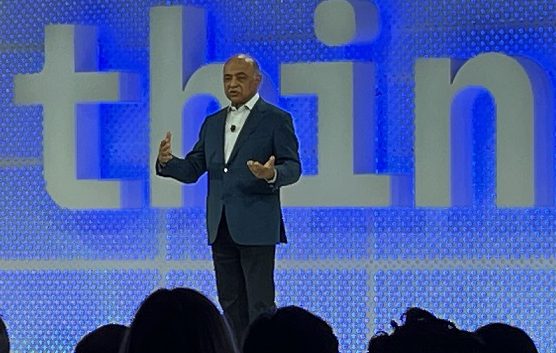 AI
AI
 AI
AI
 AI
AI
In IBM Corp.’s view of the world, the tech industry is coming to a place where the intersection of cloud, artificial intelligence and quantum computing will trigger a significant transformation.
“It’s a massive moment of technological advancement,” Chief Executive Officer Arvind Krishna (pictured) said in his keynote address during the IBM Think conference in Orlando on Tuesday. “We are going to see an incredible inflection point.”
IBM’s preparation for this inflection point became clearer during presentations this week, as executives from the major business units outlined a roadmap for the company in a fast-moving environment. Not surprisingly, AI was a central focus.
The company unveiled its Watsonx product suite for customers to build and deploy AI models more easily. A data lakehouse, access to a wide range of models and governance tools form the key elements of IBM’s latest AI offering.
“There’s a lot of momentum, there’s a lot of value and that’s what we want,” Krishna said. “AI is expected to unlock $16 trillion worth of productivity. How do you deploy AI at scale? That is what we want to do.”
To roll out AI at large scale, IBM has formed a partnership with startup Hugging Face Inc., operator of a GitHub-like platform for hosting AI and machine learning models. Although Watsonx will offer IBM-developed models, it will also provide access to Hugging Face’s thousands of open-source neural networks and datasets.
This week’s partnership with IBM is just one of a series of alliances for the rapidly growing Hugging Face. The startup company has been a collaborator with Amazon Web Services Inc. since 2021, and recently announced alliances with Service Now Inc. and Databricks Inc. Hugging Face now has 15,000 companies using its platform, including Google LLC, Meta Platforms Inc. and Bloomberg L.P., co-founder and CEO Clem Delangue said during an appearance on Wednesday.
“The energy in open-source AI is insane these days,” Delangue said. “Just last week 4,000 new models were shared.”
A core element in IBM’s AI strategy is the foundation model. The new era of AI represents a shift from task-specific models to ones trained on a wide range of unlabeled data that can accomplish tasks with minimal fine tuning, and that’s what a foundation model can provide.
IBM built Vela, an AI supercomputer, to develop a software stack optimized for foundation model usage. By reducing time spent labeling data and programming models, IBM believes, businesses will be more inclined to deploy AI throughout the enterprise.
“You can now do hundreds, if not thousands, of tasks based on an underlying foundation model,” Krishna said. “That is a significant advantage.”
 An example of what that means for IBM’s customers can be found in the National Aeronautics and Space Administration. In a collaboration announced in February, NASA and IBM are working to apply foundation models to a vast trove of information gathered from earth observation satellites.
An example of what that means for IBM’s customers can be found in the National Aeronautics and Space Administration. In a collaboration announced in February, NASA and IBM are working to apply foundation models to a vast trove of information gathered from earth observation satellites.
“NASA and IBM are partnering to find out how foundation models can work with geospatial data,” said NASA Chief Science Data Officer Kevin Murphy said in a presentation. “Our goal is to speed up the pace of scientific research. Foundation models are critical to that.”
Although foundation models form a critical element of IBM’s AI deployment, quantum computing remains a key part of the company’s business strategy. In March, the company deployed the first U.S.-based private-sector quantum computer to the Cleveland Clinic for healthcare research.
The deployment represented a signal that the larger impact of commercial quantum networks may not be as far away as people once thought. “Quantum computing is very much here and very real,” said Krishna. “We can begin to work on problems that may impact all of us.”
One of those problems is quantum itself. The technology provides an ability to hack and dismantle modern cryptographic algorithms, creating a potentially massive security threat.
To address that issue, IBM announced on Wednesday the release of Quantum Safe technology, a set of tools and capabilities for protecting against data encryption-breaking attacks by the powerful technology. The solution allows organizations to scan code and identify cryptographic assets and dependencies. IBM Quantum Safe Remediator allows users to test remediation patterns and understand quantum’s potential impact on systems.
“Many clients do not know what cryptography encrypts their technology and where,” said IBM Fellow Ray Harishankar. “Our mission is to bring useful quantum computing to the world and to make quantum safe.”
IBM has quietly emerged as one of the leaders in developing protocol standards for cybersecurity in quantum computing. In July, the U.S. National Institute of Standards and Technology or NIST announced selection of the first group of encryption algorithms for a post-quantum world. Three of the four selected – CRYSTALS-Kyber, CRYSTALS-Dilithium and Falcon digital signature – were developed by the IBM team.
“Cryptography is the enterprise’s ultimate line of defense,” Harishankar said. “The time to start is now.”
THANK YOU